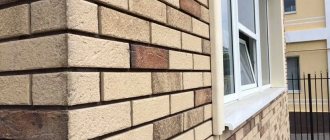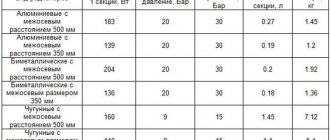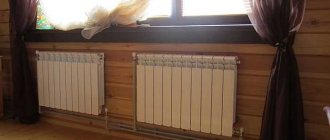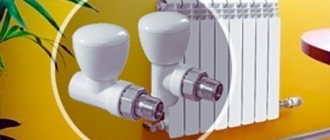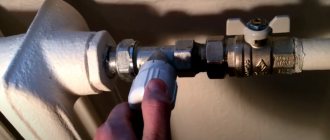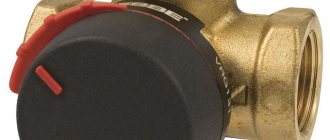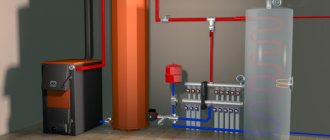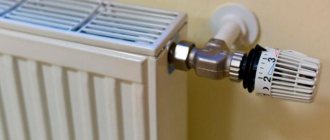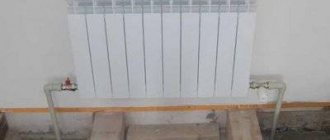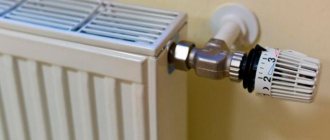"Smart" thermal head.
A valve for a heating radiator is a locking mechanism that is used to regulate the amount of coolant supplied to the heating element. Many people do not attach much importance to valves, although experts insist on their presence in any heating circuit. Let it be a centralized heat supply, an autonomous heating system for a private house or a boiler room for several apartments. Installing a tap on a heating radiator will help solve many problems related to the functioning of the heating wiring and economical energy consumption.
The modern market offers a wide range of battery taps:
- ball full stroke;
- Mayevsky crane;
- thermostatic valve with manual or automatic adjustment.
Each of the devices described above has its own advantages and disadvantages and is used to solve different problems. However, their presence in any heating circuit is mandatory.
Which battery locking mechanism should I choose?
The modern market offers the following types of radiator taps:
- regular ball
- locking mechanism with manual and electronic control.
The first one is purchased if the radiator simply needs to be temporarily cut off from the coolant supply. The second two options are great for adjusting the room temperature.
The design of the heating battery tap with a manual thermostat allows you to control the air temperature within the range from -6°C to +30°C. The electronic mechanism is characterized by great capabilities. Thus, it regulates the air temperature with greater accuracy, and at the same time can work without human intervention for up to several days. This video will help you understand the operation of the thermostatic valve for heating radiators:
What happens if you turn off both taps?
In this case, it is ideal to turn to the laws of physics. Today we have hot water, but tomorrow it will be turned off. We took and turned off both taps. What will happen? While the water is hot, it will completely fill the battery, but as soon as the water begins to cool, its volume in the battery will begin to decrease. Reducing the volume in the battery will cause a vacuum to form there.
What is a vacuum, and why is it so scary? As children, we all sucked air out of a plastic bottle for fun. Remember what happened? The bottle was shrinking. Those who were especially gifted were able to flatten it very much. What's happened? What happened was that we sucked the air out of the bottle, lowering the pressure. Of course, there was still a long way to go to vacuum, but even in this case the bottle was greatly deformed. If you connect a pump to such a bottle and start pumping out the air to the end (to a vacuum), then the bottle will simply shrink to a point. Just imagine how much pressure your battery will experience after a vacuum begins to form inside it. In the worst case, it will become deformed, in the worst case, it will crack. Therefore, after the end of the heating season, do not turn off both taps under any circumstances!
By reading my blog, you are probably making repairs.
this page to your bookmarks . This is where all the useful home improvement stores are located.
Installation of shut-off valves in different sections of the circuit
A variety of heating taps can have different purposes, which is why the installation of devices is carried out in the areas provided for by the project. As a rule, the heating circuit will give clear recommendations as to what type of shut-off valves should complement the various types of radiators connected to the circuit.
Neglecting the recommendations may result in a decrease in the performance of the heating system.
Therefore, it is better for the owner to buy a heating control valve provided for in the project. A valve installed on the radiator to bleed air from the heating system helps prevent air in the radiators and avoid the appearance of cold spots.
Ball valve design and types
Ball valves are usually used for installation on radiators. This is a relatively simple device that consists of the following elements:
- gate;
- rod with seal;
- sealing washer;
- sealing seats;
- housing and adjusting nuts;
- control handle;
- frame.
The shutter is a metal ball with a hole in the center. The handle allows you to move the shutter to one of two positions: “closed” or “open” - by turning it 90 degrees. Such a simple device ensures a reliable design and a relatively low price.
Most often, ball valves are made of durable brass or similar alloys; durable modern plastics and effective lubricants are also used in their production. Another advantage of the ball valve is its compact size. For a small device it is easier to choose a suitable place in the system.
The diagram shows in detail the design of a ball valve, which allows you to understand the operating principles of this simple and reliable design
Depending on the throughput there are:
- full bore;
- standard;
- partial bore ball valves.
The first pass 90-100% of the coolant flow, the second - about 70-80%, and the third - only 40-50%. For installation on a radiator, it is recommended to install full-bore structures that will ensure that there are no significant obstacles to the coolant, which has a beneficial effect on the efficiency of heating the room.
On sale you can find ball valves made of plastic, but they are not suitable for hot water supply or heating pipelines because they do not withstand high temperatures. Brass ball valves for radiators are also distinguished by installation method:
- coupling;
- flanged;
- welded;
- combined.
Coupling taps are usually recommended for use when installing heating systems; they are also suitable for water and gas pipelines. They are used both in residential premises and in the arrangement of public buildings. These are small devices, easy to use and very reliable. They are easy to install and usually do not require special, complex equipment. Such structures are mounted on pipes with a cross-section of no more than 40-45 mm.
When choosing valves for larger diameter pipelines, it is recommended to pay attention to flanged designs. They are designed for pipelines with a diameter of more than 50 mm. During installation, be sure to use special sealing gaskets to ensure sufficient strength and tightness of the connection between the tap and the pipeline. Flanged ball valves are strong enough to be used in heating systems.
There are collapsible flanged valves and non-separable ones. The first ones have a collapsible body, which will be very convenient when replacing worn or damaged parts. Most often, replacement requires a gasket, sometimes you have to install a new valve, etc. Non-separable flanged valves have a one-piece body. If it breaks, you have to completely replace the entire structure.
Welded structures are installed by welding, as the name implies. Since dismantling such a structure cannot be called simple, devices of this type are installed in places with limited access. Ball valves should only be welded by specialists who have the necessary qualifications.
A weld-on ball valve is quite difficult to install because it requires skilled welding. Such devices are installed in places that cannot be easily accessed.
Combined designs can combine several installation methods. Such valves can be straight-through, angle, multi-way (for example, three-way). The latter type is not often used in the installation of heating systems, since it is used in systems where mixing or redirection of various media is necessary.
Although it is best to use taps made of brass or its alloys for heating systems, silumin control structures that are less durable and cheaper can be found on sale. Outwardly, they are very similar to brass taps and can be passed off as expensive originals by unscrupulous sellers. Before purchasing, you should consult with a professional craftsman who will help you identify a fake and make the right choice.
Ball valves made of silumin are inexpensive, but are characterized by low resistance to loads and corrosion. Such designs should not be installed on radiators.
Silumin structures in heating systems can withstand loads for no more than a year, then they break. This material is extremely poorly resistant to increased loads, such as water hammer, and is noticeably susceptible to corrosion. Sometimes a silumin tap for a heating radiator simply falls off the pipeline when the tap is closed or opened. This can cause significant and serious burns. In addition, when using low-quality taps, leaks often occur. As a result, more than one floor may be flooded.
Before purchasing heating pipes and taps, you need to calculate the number of radiator sections to ensure good heating of the rooms. You will learn how to do this correctly from our article:.
Advantages
When installing a modern heating system, even at the stage of its development, the specialist will definitely recommend that the customer install taps on the radiators. As a result, the owner of the object receives a number of benefits:
- Possibility to disconnect/connect the battery, regardless of the time of year and heating season. The battery can become clogged, break, or leak, and a simple turn of the tap will stop the flow of coolant and allow you to immediately carry out the necessary manipulations with the device.
- If the apartment or house becomes too hot due to sudden warming, to which the heat suppliers did not have time to respond in a timely manner, simply turn off the battery. When the temperature reaches a comfortable level, the battery is turned on again.
- A tap installed at the bottom of the radiator allows you to quickly and accurately drain the coolant into a separate container or even directly into the sewer before dismantling. This will significantly save time and effort on cleaning after repairing or replacing the radiator.
- The presence of taps allows for regular radiator maintenance to remove contaminants from the system and air trapped in the pipes. As a result, the battery will last longer and the heating quality will improve.
Sometimes apartment owners worry that the faucet can easily leak or break. To prevent this from happening, you should choose high-quality equipment and carefully follow the installation technology.
